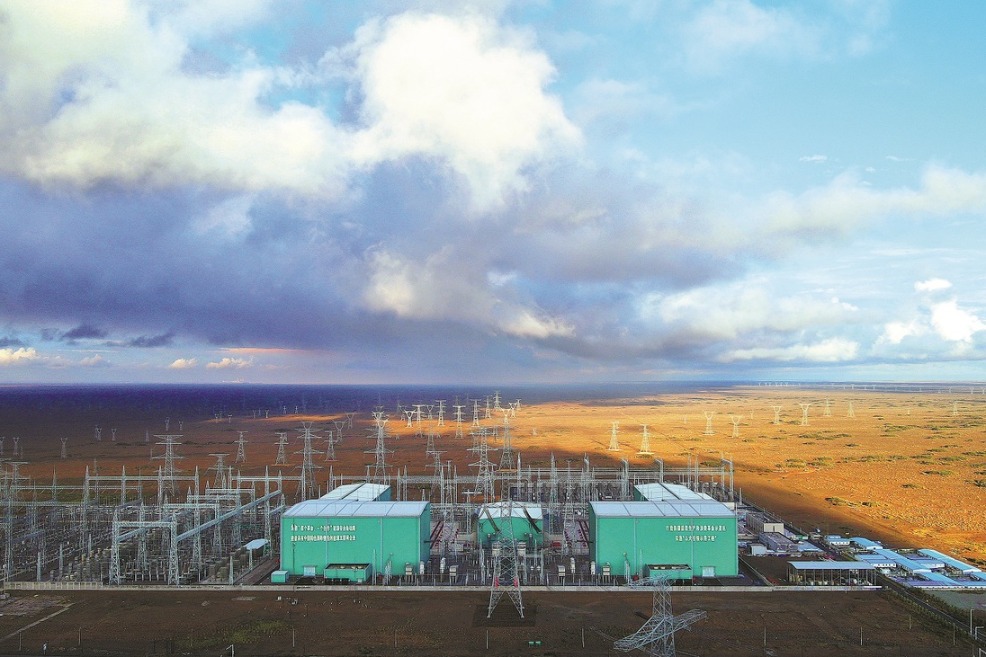Reviving retired wind turbine blades for sand control

LANZHOU -- After enduring harsh desert conditions, massive retired wind turbine blades are set to be locally repurposed as an innovative material used for sand control.
Chinese "sand scientists" have proposed a groundbreaking solution: transforming used wind turbine blades into porous sand barriers. This initiative is a significant win in both countering desertification and addressing waste management challenges in new-energy industry.
The research, conducted by researchers from the Dunhuang Gobi Desert Ecological and Environmental Research Station of the Northwest Institute of Eco-Environment and Resources (NIEER) under the Chinese Academy of Sciences, was recently published in the journal International Soil and Water Conservation Research.
"The new solution was inspired by our long-term study on sand evolution, sand-control materials and their engineering applications. It also echoes current and future demands of the new energy industry in treating damaged or retired wind turbine blades," Liu Benli, leader of the study, told Xinhua.
A SECOND LIFE IN THE DESERT
Wind farms in western China are often built near to or within the desertified areas. "This geographical overlap enhances the value of recycling turbine blades as raw materials for sand control," Liu added.
Dunhuang, home to the world renowned Mogao Grottoes, sits on the eastern edge of the Kumtag Desert. The small city in Northwest China's Gansu province, has long battled wind and sand, with oases accounting for only 4.5 percent of its total land area.
While existing sand fixation measures can be effective, conventional materials, such as straw and reeds naturally decompose overtime, limiting their durability and strength, according to Liu.
"It is crucial to explore new sand control materials that can adapt to harsh environments," Liu emphasized.
China's sand control and new-energy production development are advancing in parallel, especially in its western regions. Wind turbines, which often dot these vast landscapes, typically have a lifespan of 20 to 25 years. Many of those installed in the 2000s are set to be retired around 2025.
"Fortunately, our tech idea was just right for the demands of a local clean-energy company, which contacted our team to offer used blades for waste utilization research," Liu told Xinhua.
The researchers then cut, drilled and processed the retired blades into a new type of porous sand barrier.
BREATHING NEW LIFE INTO RETIRED BLADES
The newly developed sand barrier features both a unique material structure and exceptional physical properties. Tests have shown that it has a bending strength 14 times greater than wood composite board, along with excellent thermal stability, UV aging resistance and wear resistance.
Wind tunnel experiments and numerical simulations further demonstrated its effectiveness in altering wind-blown sand flow patterns and significantly reducing sand transport near the ground surface.
"It is suitable for those areas tortured by severe sand damage with large temperature difference, strong ultraviolet radiation and frequent wind and sand activities," Liu said.
By the end of the 14th Five-Year Plan (2021-2025) period, China will see its first wave of wind turbine blade retirements, with over 1.2 million kilowatts of wind farms surpassing 20 years of operation, according to a report published by the wind and solar equipment recycling committee under the China National Resources Recycling Association.
By the end of the 15th Five-Year Plan (2026-2030) period, annual wind turbine retirements are projected to reach around 10 million kilowatts, said the report.
"In the future, these retired wind turbine blades can be locally transformed and reused by using our new technology, achieving the goal of recycling locally," said He Chenchen, a member of Liu's team.
Further studies and field experiments will continue to refine the material, ensuring it meets local demands, Liu added.
- Chinese VP addresses dialogue on exchanges, mutual learning among civilizations
- China to crackdown on illegal, fake college entrance exam information
- China's housing policy drives poverty reduction, job growth: official
- China honors outstanding scientists in museum on Sci-tech Workers' Day
- Intl mayors praise Shanghai's development
- China sees 3.8% increase in inter-regional trips in Jan-April




































